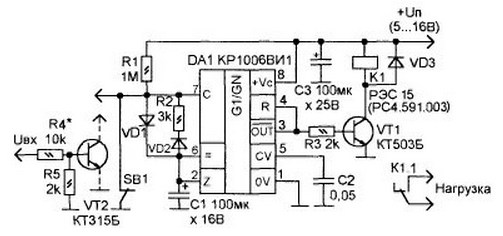Popular chip CREW contains two precision comparator ensuring the accuracy of the comparison voltages is not worse than 1%. This chip is the basis for constructing various devices such as multivibrators, converters, parts delays, etc.
Offer their own version of the timer on CREW, which features high stability time intervals.

Timer control DA1 is input the high level pulse (logical "1") input (pin 7). When pin 7 - low level (logic 0), the comparator is locked, and charging the capacitor C1 is not performed. The output DA1 3 - high level. Run timer button SB1, but instead may be any scheme management with consistent output level ("1").
When the contacts SB1 is open, i.e. DA1 pin 7 goes to a high level, the capacitor C1 is charged through the chain R2-VD2. At the output (pin 3) - still high level. After some time (when specified in the scheme the values of R2 and C1 is about 3 min), the voltage on C1 reaches the trigger level of the comparator, and the output DAT appears the low level ("0"). It is not change (until you turn off the power to the node).
The time delay depends on of the values of C1 and R2 and can be varied within wide limits.
Diodes VD1, VD2 entered in the scheme to reduce the influence of the leakage current of the capacitor C1 on the stability time interval. The VD3 diode prevents voltage spikes during commutation relay K1. The capacitor C3 smooths the ripple of the power supply. Conclusion 3 DA1 is connected to the reset input R (pin 4) to prevent the device from going into self-oscillating mode.
To operate the timer in a contactless manner at the entrance instead SB1 enough to install a simple inverter (shown in the diagram by a dotted line).
The resistance R4 is selected depending on the magnitude of the input signal. The timer works when applying "0" to the base of VT2.
Fixed resistors -~ MLT-0,25. Oxide capacitors C1 and C3 - C50-24 or similar, S2 - type CM. Transistors - CT, CT. KT315 with any letter index. The diodes can be replaced by D. D, CD and similar.
Author: A. Kashkarov, G. S. Petersburg






